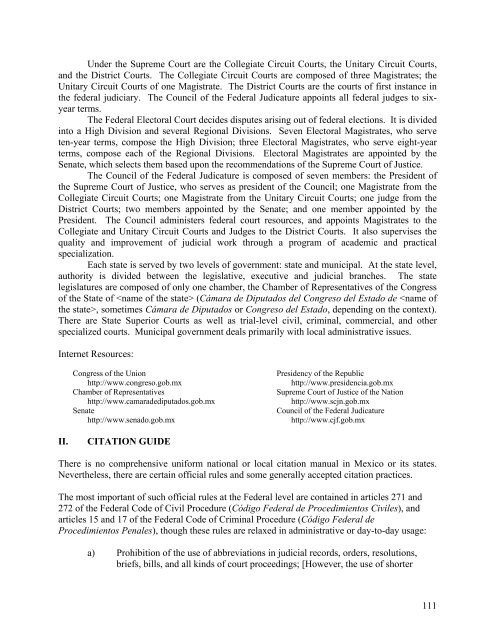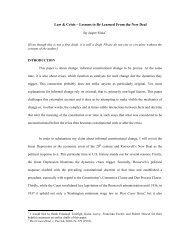Guide to Foreign and International Legal Citations - New York ...
Guide to Foreign and International Legal Citations - New York ...
Guide to Foreign and International Legal Citations - New York ...
You also want an ePaper? Increase the reach of your titles
YUMPU automatically turns print PDFs into web optimized ePapers that Google loves.
Under the Supreme Court are the Collegiate Circuit Courts, the Unitary Circuit Courts,<br />
<strong>and</strong> the District Courts. The Collegiate Circuit Courts are composed of three Magistrates; the<br />
Unitary Circuit Courts of one Magistrate. The District Courts are the courts of first instance in<br />
the federal judiciary. The Council of the Federal Judicature appoints all federal judges <strong>to</strong> sixyear<br />
terms.<br />
The Federal Elec<strong>to</strong>ral Court decides disputes arising out of federal elections. It is divided<br />
in<strong>to</strong> a High Division <strong>and</strong> several Regional Divisions. Seven Elec<strong>to</strong>ral Magistrates, who serve<br />
ten-year terms, compose the High Division; three Elec<strong>to</strong>ral Magistrates, who serve eight-year<br />
terms, compose each of the Regional Divisions. Elec<strong>to</strong>ral Magistrates are appointed by the<br />
Senate, which selects them based upon the recommendations of the Supreme Court of Justice.<br />
The Council of the Federal Judicature is composed of seven members: the President of<br />
the Supreme Court of Justice, who serves as president of the Council; one Magistrate from the<br />
Collegiate Circuit Courts; one Magistrate from the Unitary Circuit Courts; one judge from the<br />
District Courts; two members appointed by the Senate; <strong>and</strong> one member appointed by the<br />
President. The Council administers federal court resources, <strong>and</strong> appoints Magistrates <strong>to</strong> the<br />
Collegiate <strong>and</strong> Unitary Circuit Courts <strong>and</strong> Judges <strong>to</strong> the District Courts. It also supervises the<br />
quality <strong>and</strong> improvement of judicial work through a program of academic <strong>and</strong> practical<br />
specialization.<br />
Each state is served by two levels of government: state <strong>and</strong> municipal. At the state level,<br />
authority is divided between the legislative, executive <strong>and</strong> judicial branches. The state<br />
legislatures are composed of only one chamber, the Chamber of Representatives of the Congress<br />
of the State of (Cámara de Diputados del Congreso del Estado de , sometimes Cámara de Diputados or Congreso del Estado, depending on the context).<br />
There are State Superior Courts as well as trial-level civil, criminal, commercial, <strong>and</strong> other<br />
specialized courts. Municipal government deals primarily with local administrative issues.<br />
Internet Resources:<br />
Congress of the Union<br />
http://www.congreso.gob.mx<br />
Chamber of Representatives<br />
http://www.camaradediputados.gob.mx<br />
Senate<br />
http://www.senado.gob.mx<br />
II. CITATION GUIDE<br />
Presidency of the Republic<br />
http://www.presidencia.gob.mx<br />
Supreme Court of Justice of the Nation<br />
http://www.scjn.gob.mx<br />
Council of the Federal Judicature<br />
http://www.cjf.gob.mx<br />
There is no comprehensive uniform national or local citation manual in Mexico or its states.<br />
Nevertheless, there are certain official rules <strong>and</strong> some generally accepted citation practices.<br />
The most important of such official rules at the Federal level are contained in articles 271 <strong>and</strong><br />
272 of the Federal Code of Civil Procedure (Código Federal de Procedimien<strong>to</strong>s Civiles), <strong>and</strong><br />
articles 15 <strong>and</strong> 17 of the Federal Code of Criminal Procedure (Código Federal de<br />
Procedimien<strong>to</strong>s Penales), though these rules are relaxed in administrative or day-<strong>to</strong>-day usage:<br />
a) Prohibition of the use of abbreviations in judicial records, orders, resolutions,<br />
briefs, bills, <strong>and</strong> all kinds of court proceedings; [However, the use of shorter<br />
111
















